Hōunsai Konomi: Celebrating 101 Years
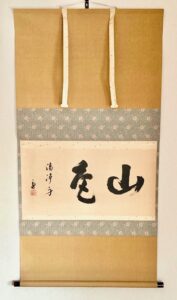
Kake-jiku, 掛軸, hang-scroll, with calligraphy, San-shoku Shō-jō-shin, 山色清浄身, Mountain-color pure-pure-body, by Hō-un-sai, 鵬雲斎, ‘Phoenix’-cloud-abstain, written prior to 1976. The text likens the landscape to the body of the Buddha.
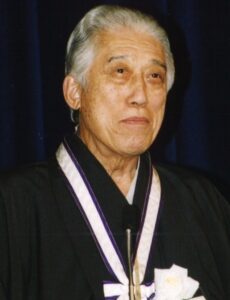
Hō-un-sai, 鵬雲斎, ‘Phoenix’-cloud-abstain, is the Buddhist name of Sen Sō-shitsu, 千宗室, Thousand Sect-room, XV Ie-moto, 家元, House-origin, Headmaster of Ura-sen-ke, 裏千家, Inner-thousand-family; 1913-present. Since his retirement, he is called Gen-shitsu, 玄室, Mystery-room, and is called Dai-sō-shō, 大宗匠, Great-sect-artisan.
In the family of Urasenke, the presiding head master, iemoto, is named Sō-shitsu, 宗室, Sect-room. This was established by Rikyū’s grandson, Sō-tan, 宗旦, Sect-dawn, when he divided his family into four branches, naming each of his sons as heads of their families. After attaining Buddhist training, another name is bestowed on individuals, and Sōshitsu XV was given the name ‘Hō-un-sai’, 鵬雲斎, ‘Phoenix’-cloud-abstain. He will continue to be identified by this name after his death. The name suffix –sai, 斎, refers to his Buddhist identity.
The original Kanji for sai is 齋, which is also read tsutsushimu, toki, monoimi, and means Buddhist food, room, religious purification, worship, avoid, alike, etc. In Buddhism, the Kanji means to show one’s piety before offering sacrifices and other ceremonies in ancient times, by abstaining from meat and alcohol, bathing oneself and clearing one’s mind of distracting thoughts, solemn, earnest, etc. The Kanji is based primarily on the Kanji, shi, 示, which means god, as well as show, indicate, point out, express, display, etc.
It should be understood that the place for presenting Chanoyu is called a cha-shitsu, 茶室, tea-room.
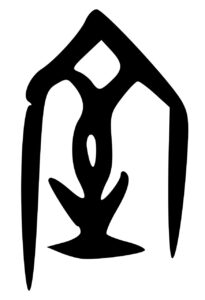
The origin of the Kanji shitsu, muro, 室, room, is the pictogram of a house with an arrow stuck in the ground. It means a place where one stops and lives. In architecture, it specifically refers to a room behind the wall of a hall. It is a sort of inner chamber.
The name Gen-shitsu, 玄室, could mean ‘dark room’. The Kanji, gen, 玄, is also read kuro, kuroi, and means deep, profound, mysterious, black, reddish black, sky, etc. Gen, 玄, is part of the name of Gen-gen-sai Sei-chū, 玄々斎精中, Mystery-mystery-abstain Spirit-middle, XI Iemoto of Urasenke. Other head masters of Urasenke with the name Gen, 玄, include Yū-gen-sai I-ttō, 又玄斎一燈, Again-mystery-abstain One-lamp, VIII Iemoto. Za-bō-sai, 坐忘斎, Sit-forget-abstain, Gen-dama, 玄黙, Mystery-silence, XVI Iemoto, [present].
The Kanji gen, 玄, is also identified with the north, which is dark and mysterious, and is part of the name of the guardian of the north quadrant of the sky, Gen-bu, 玄武, Black-warrior.
The origin of the Kanji gen, 玄, resembles a hyō-tan, 瓢箪, gourd-basket, the bottle gourd which is sacred to Taoism. Its double-chamber is a manifestation of mystery/darkness upon mystery/darkness. The gourd is a natural vessel to hold water, and water is emblematic of the north, according to the Eki-kyō, I Ching, 易経, Change-sutra. Gen-gaku, 玄学, Mystery-study, is the study of occult aspects of Taoism and Buddhism.
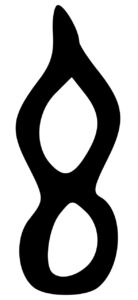
Hōunsai Daisōshō, 鵬雲斎大宗匠, has had many names in his long and extraordinary life. Subsequently, he also has used many different stamps han-ko, 判子, seal-of. His name Hōunsai is written with the Kanji for hō, ōōtori, 鵬, peng, also called a ‘phoenix’, from China, is a giant bird said to transform from a fish.
In his early life, Hōunsai’s name was Masa-oki, 政興, Govern-revive. During the Second World War, he was trained as a pilot. After the war, he welcomed Americans to his home in Kyōto, and was at that time called ‘Mike’. In June 1948, while Zen training at Dai-toku-ji, 大徳寺, Great-virtue-temple, he received the title of Hō-un-sai Gen-shō Kō-ji, 鵬雲斎玄秀宗興居士, ‘Phoenix’(Peng)-cloud-abstain Mystery-excel Is-gentleman. This name, was given to him by Go-tō Zui-gan Rō-shi,後藤瑞巌老師, Latter-wisteria Auspicious-cliff Old-master, abbot of Daitokuji.
The name ‘Peng-un-sai’, 鵬雲斎, has its origins in the Heki-gan-roku, 碧巌録, Blue-cliff-record, a compendium of Zen stories and kō-an, 公案, public-examination, from the Northern Song Dynasty in China; “Hane wo hiro-gete Hō-tō su roku-gō no kumo,” 翅を展げて鵬騰す六合の雲, Wings do unfold ‘phoenix’ rises six-unite’s cloud. Roku-gō is a metaphor for the universe.
The Kanji for his name hō un, 鵬雲, phoenix cloud, were altered. The Kanji for tori, 鳥, bird, was removed from the Kanji for phoenix, 鵬, which left the Kanji for tomo, 朋, friend. The Kanji for ame, 雨, rain, was removed the Kanji for kumo, 雲, which left the Kanji for un, 云, say, and which implies cloud. Traditionally, Japanese writing is from right to left, so that Hōunsai’s stamp places the Kanji 云 on the right, with the Kanji 朋 on the left. Both Kanji 雲鵬 have Chinese origins, and parts of the Kanji, 云 and 朋, have the on-yomi, 音読み, sound-read, the so-called Chinese reading. Classically, Hōunsai’s name would be written in Japanese from right to left, 斎雲鵬. This is the arrangement of Kanji on his stamp, without the Kanji for sai, 斎, abstain.

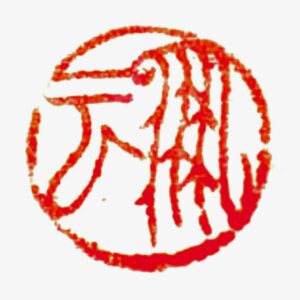
The Kanji for tomo has been drawn to resemble the tail of the phoenix, which also resembles trailing willow branches. Hōunsai has been recognized and acknowledged calligrapher.
Ding Yun-peng, 丁雲鵬, Ward Cloud-phoenix (1547-1628?), was a celebrated Chinese painter of human figures, including Buddhist and Taoist subjects, and landscapes during the 明Ming Dynasty. He followed the style of the Song Dynasty, and used intricate and exquisite brush strokes. In the realm of tea, Ding Yunpeng is most renowned for his lengthy series of scenes depicting the enjoyment and details of sen-cha, 煎茶, steeped tea.
![]()
Dai-toku-ji, 大徳寺, Great-virtue-temple, has had a deep connection with the Senke families since the time of Sen no Rikyū. The o-haka, お墓, hon. -tomb, of Rikyū is located at the sub-temple and Jukō-in, and it is known as the family temple of the Senke family. After Rikyū was forced into sep-puku, 切腹, cut-belly, at the behest of Toyo-tomi Hide-yoshi, 豊臣秀吉, Excellent-retainer Surpassing-joy, his grandson Sen Sōtan, 千宗旦, Thousand Sect-dawn, the 3rd generation, who rebuilt the Senke school is said to have entered San-gen-in, 三玄院, Three-mystery-institute, a sub-temple of Daitokuji, to practice as a child at Rikyū’s request.
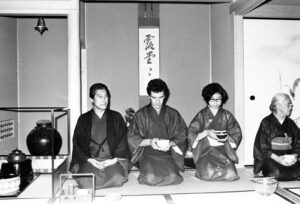
Hōunsai as shō-kyaku, 正客, first-guest, at a cha-kai, 茶会, tea-gathering, in 1972, at San-gen-in, 三玄院, Three-mystery-sub temple, in Dai-toku-ji, 大徳寺, Great-virtue-temple, Kyōto. The lady pictured at the far right is Hama-moto Sō-shun Sen-sei, 濱本宗俊先生, Beach-origin Sect-excellence Before-live, acknowledged master of Chanoyu. The second guest is myself.
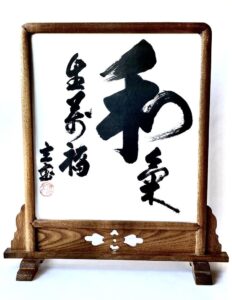
Shiki-shi, 色紙, color-paper, with calligraphy, Wa Ki Ju-Fuku Jō-zu, 和気生寿福, Harmony spirit life longevity fortune; a harmonious atmosphere creates longevity and fortune, and signed Gen-shitsu, 玄室, Mystery-room, with his red seal which Hōunsai Sama uses after bequeathing his title of Ie-moto, 家元, House-origin, to his son, Za-bō-sai, 坐忘斎, Sit-forget-abstain. The shikishi is displayed in a free-standing shikishi tate, 立, stand, made of kuwa, 桑, mulberry.
The shikishi was a gift of Hōunsai during the 60th Anniversary of Urasenke Boston, on October 12, 2019. In 1976, Hōunsai Sama asked I would go to teach in Boston for a couple of years, which was 48 years ago.
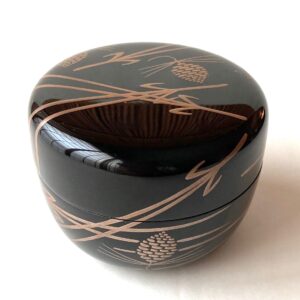
Hira-natsume, 平棗, wide-jujube; gold and black lacquered covered container with a design of matsu-kasa, 松笠, pine-cone, and matsu-ba, 松葉, pine-leaf; diam. 2.5 sun kane-jaku or 2 sun kujira-jaku, by Naka-mura Sō-tetsu, 中村宗哲, Middle-town Sect-sage. The fallen pine cones and needles are emblematic of the cycle of beginning and ending.
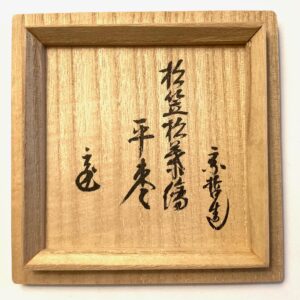
Hako no futa, 箱の蓋, box ’s lid, underside with hako-gaki, 箱書, box-writing, from right; Sō-tetsu zō, 宗哲造, Sect-sage made, matsu-kasa matsu-ba zō, 松笠松葉像, pine-cone pine-leaf image, hira-natsume, 平棗, wide-jujube, signature of Hōunsai.
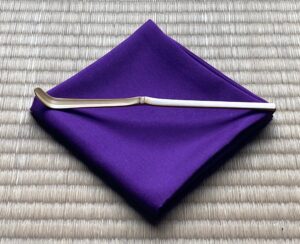
Cha-shaku, 茶杓, tea-scoop; take, 竹, bamboo, naka-bushi, 中節, middle-node, by Kuro-da Shō-gen, 黒田正玄, Black-field True-mystery, named ‘Te wo toriatte’, 手をとりあって, hand taking hand, by Hōunsai, 鵬雲斎, ‘Phoenix’-cloud-abstain, Sen Sō-shitsu, XV, Ie-moto, 家元, House-origin, Dai-sō-shō, 大宗匠, Great-sect-artisan, Urasenke. Kuro-da Shō-gen, 黒田正玄, Black-field Correct-mystery, is one of the Sen-ke Ji-sshoku, 千家十職, Thousand-families Ten-professional.
The chashaku was given to me in 1976 when Hōunsai Sama asked if I would go to Boston to teach Chanoyu. The name, to my knowledge, was used for the first time. We often greeted each other holding both our hands together. It was at that time that he honored me the Cha-mei, 茶名, Tea-name, Sō-sei, 宗清, Sect-pure.
The chashaku is displayed on a purple silk fuku-sa, 帛紗, cloth-gauze, by Toku-sai, 徳斎, Virtue-abstain, Kyōto. The chashaku length of 6.3 sun kane-jaku is equal to the diagonal measurement of the fukusa folded into quarters.
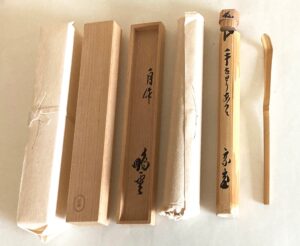
Hōunsai’s chashaku and containers made by Kuro-da Shō-gen, 黒田正玄, Black-field True-mystery: from left – cha-shaku, 茶杓, tea-scoop; bamboo tomo-zutsu, 共筒, together-tube, with calligraphy, ‘Te wo toriatte’, 手をとりあって, hand taking hand, and signed Sō-shitsu, 宗室, Sect-room, Hōunsai’s name, and cedar stopper with Hōunsai’s ka-ō, 花押, flower-seal, stylized 十五, for his generation number 15; paper wrapper; lid of box with calligraphy, ji-saku, 自作, self-made, Hō-un, 鵬雲, Phoenix-cloud; box showing underside with brand Shō-gen,正玄, True-mystery; with paper wrapper and paper bowknot.
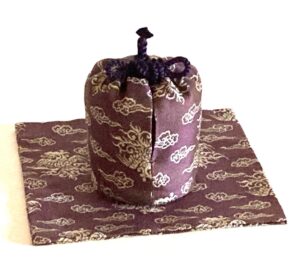
These two pieces of fabric are a set used in the Tea presentation called ‘Wa-kin date’, 和巾點, Harmony-cloth offer: Wa refers to Japan. The fabric is a shō-ha, 紹巴, help-comma, ‘herringbone’ weave, the pattern is called ‘Hō-un gire’, 鵬雲切れ, ‘Phoenix’-cloud piece, and is the choice of Hōunsai XV Iemoto, Urasenke.
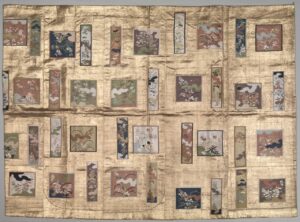
The word ‘gire’, reading altered from kire, 切れ, cut, may have origins in the patchwork fabric Buddhist ke-sa, 袈裟, camlet-surplice, made of theoretically useless cloth remnants and rags.
Pictured here is a ke-sa, 袈裟, camlet-surplice, Edo period, Cleveland Museum of Art.
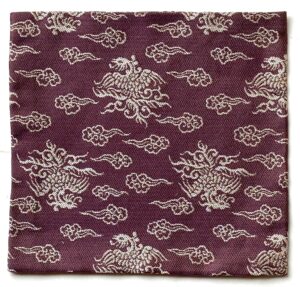
Ko-buku-sa, 古帛紗, old-cloth-gauze, purple silk with light gray pattern of ‘phoenix’ and cloud, “Hō-un Gire,” 鵬雲裂, ‘Phoenix-cloud Cut, herringbone weave called shō-ha don-su, 紹巴緞子, introduce-comma damask-of, 5 x 5.3 sun kane-jaku [4 x 4.24 sun kujira-jaku]; choice of, and named for Hō-un-sai, 鵬雲斎, ‘Phoenix-cloud-abstain, XV, Ie-moto, 家元, House-origin, Ura-sen-ke, 裏千家, Inner-thousand-family, Kyō-to, 京都, Capital-city.
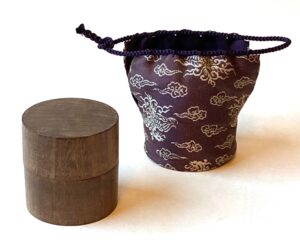
Cha-ki, 茶器, tea-container; naka-tsugi, 中次, middle-next, kuwa, 桑, mulberry, lined in gold leaf. The Tea presentation was modified by Hōunsai’s father, Tan-tan-sai, 淡々斎, Light-light-abstain, XIV Iemoto, Urasenke, by introducing the naka-tsuki, 中次, made of kuwa, 桑, mulberry.
Shi-fuku, 仕服, serve-cover, shō–ha don-su, 紹紦緞子, introduce-silk thread damask-of, with purple and white pattern of kumo ni hō, 雲に, cloud in ‘phoenix,’ called Hō-un gire, 鵬雲切れ, ‘Phoenix’-cloud piece, the choice of Hōunsai Dai-sō-shō, 鵬雲斎大宗匠, ‘Phoenix’-cloud-abstain Great-sect-master.
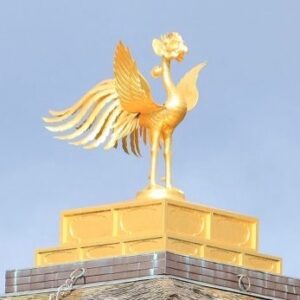
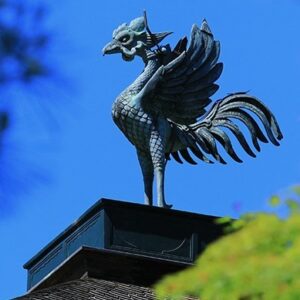
Gilt image of a hō, 鳳, ‘phoenix’ on the roof of the Kin-kaku-ji, 金閣寺, Gold-pavilion-temple, on the west side of Kyōto; completed in 1397, and restored in 1955 after its destruction in an arson attack. Like the western phoenix it rose again from ashes. Darkened image of a ō, 凰,‘phoenix’ on the roof of the Gin-kaku-ji, 銀閣寺, Silver-pavilion-temple, on the east side of Kyōto; completed in 1483. Ginkakuji has Japan’s first yo-jō-han, 四畳半, four-mat-half, room for serving Chanoyu.
The Asian ‘phoenix’ often is depicted in pairs called hō-ō, 鳳凰, [male]‘phoenix’- [female] ‘phoenix.’ Japan’s imperial couple are identified with other creatures: the emperor is likened to a tatsu, 龍, dragon, and the empress is likened to a hō, 凰, ‘phoenix’. The Asian ‘phoenix’ is entirely different from the Egyptian phoenix, and does not rise anew from ashes. The Chinese hō, ‘phoenix’ may have been inspired by a native colorful pheasant or parrot. The ‘phoenix’ remains aloft in the sky, hence the clouds, and alights only on the kiri, 桐, paulownia, tree.
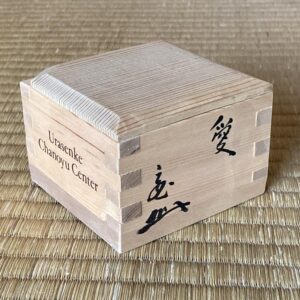
Masu, 枡, box measure, sugi, 杉, cedar, W. 2.8 sun kane-jaku, made for the 1964 opening of the Urasenke Chanoyu Center in New York City, with calligraphy ‘ai’, 愛, love, and signed by Sen Hō-un-sai, 千鵬雲斎, Thousand Phoenix-cloud-abstain, XV Iemoto, Urasenke. With lid I made from an Urasenke usu-ita, 薄板, thin-board, for sweets.
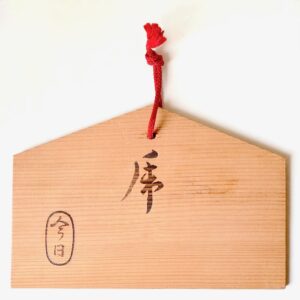
Usu-ita, 薄板, thin-board, sugi, 杉, cedar, in the pentagonal shape of an e-ma, 絵馬, horse-picture, 5.5 x 8 sun kane-jaku. The branded Kanji for tora, 乕, tiger, after calligraphy by Hōunsai, together with the branded stamp from Kanji also written by Hōunsai for Kon-nichi, 今日, Now-day, from the name of Sōtan’s Kon-nichi-an, 今日庵, Now-day-hut. Konnichian is synonymous for Urasenke.
The board was the tray for a meal celebrating the new year of Tora-doshi, 寅年, Tiger-year, 1974. The Kanji for tiger is the somewhat obscure tora, 乕, which also means brave, fierce, and is a surname. I was born in 1938, a Tiger year, which is why the board is special to me. The board has a red cord to hang it, and I use it as a han-gi, 板木, board-wood, that is hung outside near an entrance, and is struck once by a guest arriving for a Tea gathering. This procedure is derived from Buddhism in which it is struck to alert others of time and occasions. The sound of striking the board may be likened to the roar of a tiger that awakens one to spiritual realms. The observance of Ri-sshun, 立春, Begin-spring, which occurs around February 2nd or 3rd, and begins the ‘old’ Tora no Tsuki, 寅の月Tiger’s Month. Risshun is one of the 24 seasonal divisions of the solar year.
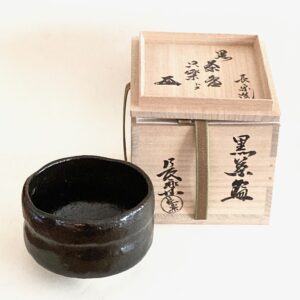
Cha-wan, 茶碗, tea-bowl, kuro-raku, 黒楽, black-pleasure, by O-gawa Chō-raku, 小川 長楽, Little-river Lengthy-pleasure, with storage box, tomo-hako, 共箱, together-box, signed on the front, kuro cha wan chō-raku, 黒茶碗長楽, black tea bowl long pleasure, and potter’s stamp. Calligraphy on the underside of the lid, hako-gaki, 箱書き, box-write, from right: chō raku so kuro cha wan ani raku, 長楽造 黒 茶碗兄楽, lengthy pleasure made black tea bowl elder brother pleasure (second generation), and ka-ō, 花押, flower-seal, stylized generation number, 15, for Hōunsai. The flat brown and green ribbon tie called Sanada himo, 真田紐, True-field cord, is identified with Urasenke.
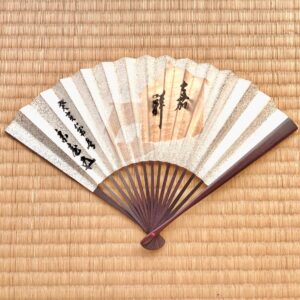
Sen-su, 扇子, fan-of, white paper folding fan with image of two e-ma, 絵馬, picture-horse, and calligraphy, Mizunoto I, 癸亥, Water’s younger brother Boar (zodiac); Kanji are also read ki-gai. The gold ema depicted on the fan has calligraphy, ka-shō, 嘉祥, auspicious-happiness, and the other image of an ema has the silhouette of an inoshishi, 猪, wild boar. It is important to understand the difference between the Kanji for the actual animal inoshishi, 猪, and the Kanji for the zodiac animal of the Wild Boar which is I, 亥.
The years marked with Mizunoto I occurred on1923 when Hōunsai was born, and 1983, the year the pictured sensu was made, Hōunsai celebrated his Kan-reki, 還暦, Return-calendar, at age 60. The next year marking Mizunoto I is 2033. On April 19, 2023, Hōunsai celebrated his 100th birthday.
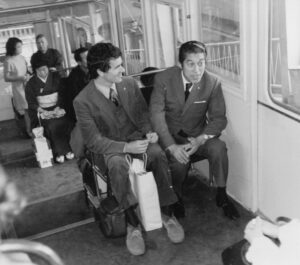
Hōunsai Sama and others, in October 6, 1972, on the cable car ascending to the Iwa-shi-mizu Hachi-man-gū, 石清水八幡宮, Rock-pure-water Eight-banners-palace, where he presented Ken-cha, 献茶, Offer-tea, to the Shintō deities. Mori Aki-ko Sen-sei, 森明子先生, Woods Bright-child Live-child, the lady in dark kimono, was the director of the group of foreigners called Midori-kai, みどり会, who were studying Chanoyu at Urasenke in Kyōto.
Hōunsai Sama invited members of Midori-kai to the offering and to attend various Tea gatherings around the shrine. Taking their seats, a woman, seated next to Hōunsai Sama, turned to see who it was, and recognizing it was Hōunsai, jumped up and hastened away. He beckoned to me to sit with him. I had begun to study Chanoyu a few months earlier. This incident showed Hōunsai’s dedication to his appreciation of foreigners and their interest in his culture, and that he felt comfortable around them. He could be himself, and not only ‘Oiemoto’.
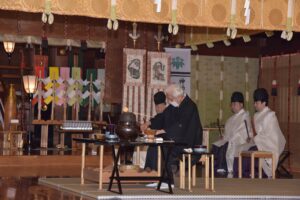
Hō-un-sai, 鵬雲斎, Pheonix-cloud-abstain, Gen-shitsu, 玄室, Mystery-room, presenting Ken-cha-shiki, 献茶式, Offer-tea-rite, at Omiya Hachi-man-gū, 大宮八幡宮, Great-palace Eight-banner-palace, in Tōkyō. The offering was also in observance of his 100th birthday.
For further study, see also: Rikyū Konomi: Favored Tea Utensils and Shikishi Picture Gallery

